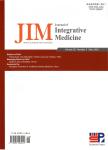Salvadora persica extract attenuates cyclophosphamide-induced hepatorenal damage by modulating oxidative stress, inflammation and apoptosis in rats
Salvadora persica extract attenuates cyclophosphamide-induced hepatorenal damage by modulating oxidative stress, inflammation and apoptosis in rats作者机构:Department of Immunology and HematologyFaculty of MedicineUmm Al-Qura UniversityMakkah 21955Saudi Arabia Department of Laboratory MedicineFaculty of Applied Medical SciencesUmm Al-Qura UniversityMakkah 7607Saudi Arabia Clinical Nutrition DepartmentFaculty of Applied Medical Sciences Umm Al-Qura UniversityMakkah 7607Soudi Arabia Clinical Pathology DepartmentFaculty of Veterinary MedicineMansoura UniversityMansoura 35516Egypt
出 版 物:《Journal of Integrative Medicine》 (结合医学学报(英文版))
年 卷 期:2022年第20卷第4期
页 面:348-354页
核心收录:
学科分类:1006[医学-中西医结合] 1002[医学-临床医学] 10[医学] 100602[医学-中西医结合临床]
基 金:the Deanship of Scientific Research Umm Al-Qura University for supporting this work by Grant Code:43309003。
主 题:Cyclophosphamide Salvadora persica Cytokine NF-κB AMP-activated protein kinases Antioxidants Anti-inflammatory agents
摘 要:Objective: Salvadora persica(SP) is used as a food additive and is a common ingredient in folk medicine.This study investigates the antioxidant, anti-inflammatory, and beneficial effects of SP against cyclophosphamide(CYP) toxicity in rats.Methods: In a 10-day study, 32 male rats were equally allocated into 4 groups(8 rats/group) as follows:the normal control(NC group), normal rats that only received oral aqueous extract of SP(100 mg/[kg·d];SP group), animals treated with intraperitoneal CYP injections(30 mg/[kg·d];CYP group), and the CYP + SP group that concurrently received CYP with SP aqueous extract. Serum samples were collected to measure the liver and renal biochemical profiles, as well as antioxidant and oxidative stress markers and the concentrations of interleukin-1β(IL-1β), IL-6, IL-10, tumor necrosis factor-a(TNF-a), nuclear factor-κB(NF-κB) and adenosine 5’-monophosphate-activated protein kinase(AMPK). Hepatic and renal tissues were also harvested for histopathology and to measure apoptosis using the terminal deoxynucleotidyl transferase-mediated dUTP nick end labeling technique, alongside tissue levels of oxidative stress markers.Results: Liver enzymes, total bilirubin, creatinine and urea, as well as serum IL-1β, IL-6, TNF-a and NF-κB increased significantly, whilst total protein, albumin, calcium, IL-10 and AMPK declined in serum of the CYP group relative to the NC group. The hepatorenal concentrations of glutathione, glutathione peroxidase and catalase declined markedly in the CYP group, whereas malondialdehyde, protein adducts, and apoptosis index increased compared with the NC group. By contrast, the hepatorenal biochemistry and apoptosis index of the SP group were comparable to the NC group. Interestingly, the CYP + SP group had significant improvements in the liver and renal biochemical parameters, enhanced anti-oxidative and anti-inflammatory effects, and marked declines in hepatic and renal apoptosis relative to the CYP group. Moreover, all monitored parameters were statistically indistinguishable between the CYP + SP group and the NC group.Conclusion: This study suggests that the aqueous extract of SP could be a potential remedy against CYP-induced hepatorenal damage and may act by modulating the AMPK/NF-κB signaling pathway and promoting anti-oxidative and anti-inflammatory activities.



